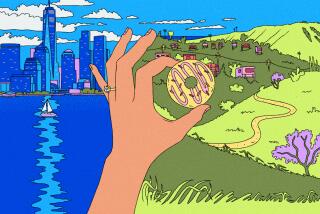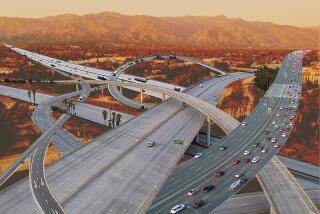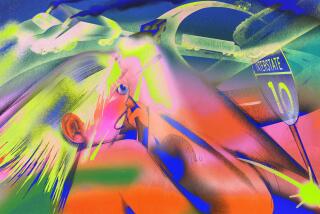Yankee Doodle Goes to Town, Driving on the Left
The approach to Gatwick was a panorama of thunderheads and shafts of sunlight playing on the dozens of different greens of the fields of Southern England. I half expected to see Spitfires ducking in and out of the cloud-filled English skies.
Or maybe Heathcliff and Kathy running hand in hand through the rain-swept fields below, or a golden coach rolling down the muddy roads, full of Henry VIII.
It’s not unusual to start a vacation full of fantasies, but neither my wife, Joyce, nor I had imagined the adventure we would be having on a simple little drive from the airport into the city, on our plenty of time to get used to the idea of driving in the British Isles. We had an English friend visiting us when the idea first came up.
“You’re concerned about driving on the left?” he had asked. “Nothing to it. Piece of cake.”
“Do you have any trouble driving here, Tom?” I asked, meaning the United States.
“Not a bit,” he said. Then after a pensive moment, “Actually, I mean I don’t think I would. I’ve never tried, you see. But you’ll have no trouble. Find it smashing.”
“Smashing?”
“Figure of speech. Means ‘piece of cake.’ ”
‘Have We a License?’
Checking through customs at Gatwick and collecting our luggage we headed for the car rental desk. It was staffed by a beautiful young woman wearing a tag that said her name was Pam. I told her our car had been ordered as part of a C.I.E. Tour, gave her my passport and a car rental voucher from my wallet, which I left on the counter.
“Have we a license to operate a motor vehicle?”
I had obtained an International Driver’s License from my auto club. I was searching my pockets for it when Pam picked up my wallet and flipped it open.
“Thought I saw that,” she said. “You’ve a California driver’s license. If you can drive in California, you can drive anywhere.”
While I was trying to figure out whether I’d been complimented or insulted, Pam finished the paper work and directed us to the U-Drive pick-up station.
The man at the pick-up station gave me a packet of maps, instructions and assorted other reading matter, escorted us to a little silver compact and even helped load the luggage. He then handed me the keys and held the right side door open while I walked around the car and climbed in on the passenger side.
“Wife going to drive, is she, sir?” As I retraced my steps and got behind the wheel the man assured me I’d “get the hang of it, driving on the proper side, inside of 20 squares” (whatever they were).
He did not tell me there was a subway strike in the United Kingdom or that there was also a railroad strike or that the general population was all over the streets with anything and everything with wheels. He just said “good luck” and walked away.
That the steering wheel was on the wrong side I could accept, but finding the gearshift on the wrong side of the steering column was a jolt. And the other controls being without labels was equally unsettling. Turning the key, however, did start the engine.
Shifting the turn-indicator into second, I pressed the gas pedal and let out the clutch. Since this had no effect at all, I overcompensated by racing the engine even more. When the rental agent turned I smiled and waved.
“Just checking,” I yelled, then showed my teeth to my wife in what I hoped would pass for another smile.
“It never hurts to check,” she said, staring dead ahead.
Turning on the lights (to warn other drivers) by pulling out a knob with a picture of a shower head on it, I shifted very carefully into low gear with my left hand and drove out of Gatwick and onto the motorway.
Six-Lane Freeway
It was a beautiful six-lane freeway with a sign indicating we were headed toward London. Glancing down, I was horrified to find we were going 80 kilometers an hour. Not realizing it translated into 49 miles an hour, Joyce and I were both looking around for the inevitable (in California) traffic cop to find we were being passed by everyone on the road as if we were parked. Most of them were hooting at us. (Hooting is the English equivalent of honking. English people do not have horns on their cars, they have hooters.)
Adjusting our speed to that of the other cars took the little compact up to 130 kilometers an hour and though I was much too busy converting right side driving to wrong side driving to concern myself with conversion tables, I later found that 130 kilometers roughly equals 80 miles an hour.
“You’re drifting,” my wife said. I was almost hypnotically drawn to the right lane. Right in America, wrong in England.
After raising four children, I had decided that I had said “close the door” so many times, it should be carved on my tombstone.
“Here lies O’Sullivan, beloved husband and father. Close the door.” On that motorway a new image formed in my mind.
“You’re drifting!”
“Thank you, dear.” Another image: “Here lies O’Sullivan, beloved husband and father. He drifted.”
They do not have trucks in the United Kingdom. They have lorries. A lorrie weighs many tons, is very tall (its headlights start approximately a yard above the rear window of the average compact car) and does not seem to able to operate on a motorway at speeds lower than 136 kilometers (85 miles an hour).
British lorrie drivers tend to think it hilarious to refrain from hooting until they are within a foot and a half of a compact car.
I was hooted by what sounded like an amplified marching band.
“Oh, my God!” I started to pull over.
“Not to the right; to the left!”
“Thank you, dear.” The lorrie thundered by and almost immediately we picked up another. I wondered if they’d been in line for a crack at me.
At near take-off speeds, we hurtled through the English countryside--dodging, praying and glimpsing cities important to any student of the English speaking world.
A highway sign flashed by which Joyce, having some experience at speed-reading, reported as saying “Roundabout. Keep Left.”
Though this made no sense at all to me, I was willing to learn. Other cars were slowing. Even the lorrie behind me was slowing. I slowed.
“This roundabout thing must be something important.”
“You’re drifting.”
“Thank you, dear.”
I learned later that we were supposed to yield to on-coming traffic in the roundabout, which turned out to be a traffic circle in the center of an intersection.
Egged on, however, by the vision of a lorrie grill and front bumper that completely filled the rear window, I shifted the turn-indicator into second and shot into the pattern of cars already in the roundabout.
As we whirled around the little circle of grass like a drunken satellite around a strange world, Joyce advised that we were receiving numerous dirty looks from the other drivers.
The dirty look, a usually effective outpouring of British outrage, is totally useless against a panicked, middle-aged American, driving a car amounting to little more than a foil-wrapped sled at high speed on the wrong side of the road in the rain.
About the third time around we saw a sign directing us toward one of the four streets out of the roundabout. It said South London and took us off the motorway and out of the high-speed driving.
“You’re drifting.”
“Thank you, dear.”
Holding His Own
We drove the surface streets through a dozen unknown districts whose names I hadn’t heard since seeing the Monty Python show on public television.
There are 18,000 licensed taxi cabs in greater London. No one knows how many other private vehicles were in use during the strikes, but it appeared that everything that would carry anything was on the streets. Even the sidewalks were crowded with foot traffic spilling out onto the roadways like water from a river at flood stage.
By keeping one hand, the left, on the gearshift lever, I was able to handle the shifting and hold my own in the heavy traffic. Whenever I saw we were approaching a particularly dangerous situation, I would activate the windscreen-washer, or the rear window defroster.
One tends to learn early-on in cars made for driving in the United Kingdom that the horn ring on the steering wheel does not operate the horn, nor would it operate the hooter if one chose to think of it as a hooter ring. In fact, all that pushing the horn ring accomplished was to make the whole assembly fall off in my lap, probably loosened by some earlier American.
In fits and snatches of starting and stopping, dashing and creeping, we worked our way through the heart of London, eyes dead ahead as if our lives depended on it. Which, of course, they did.
Shortly after dark, almost four hours after leaving Gatwick, we pulled into the parking structure at out hotel and shut off the engine of the little compact. It dieseled for a few moments before it died.
“Piece of cake,” I said to Joyce.
“You’re drifting,” she answered.
“But, we’re here.”
“About that piece of cake,” she said. “If it’s all the same with you, I think I’d rather have a drink.”
More to Read
Sign up for The Wild
We’ll help you find the best places to hike, bike and run, as well as the perfect silent spots for meditation and yoga.
You may occasionally receive promotional content from the Los Angeles Times.






